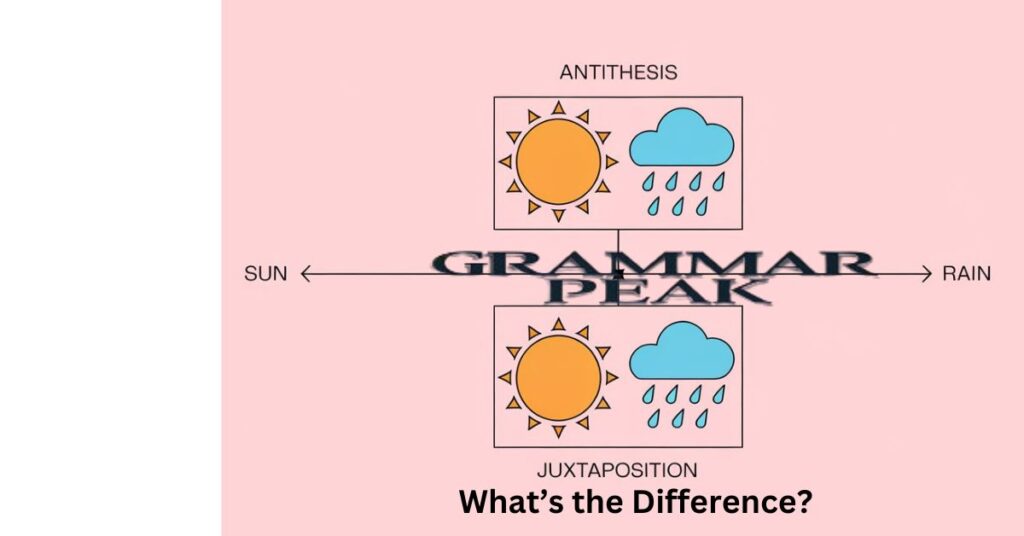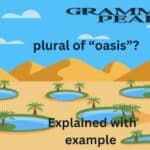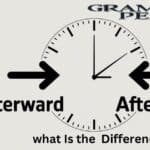Understanding antithesis and juxtaposition is vital for anyone interested in writing. These are powerful literary techniques that help convey ideas more effectively. In this article, we will explore the differences between antithesis and juxtaposition.
We will delve into their origins, provide examples of each, and discuss how to use them in your writing. By the end, you will have a deeper understanding of these important writing tools.
What is Antithesis?
Antithesis is a rhetorical device that contrasts opposing ideas in a sentence or phrase. It emphasizes the differences between two ideas to make a point clearer. For instance, a famous example is “It was the best of times, it was the worst of times.” This statement highlights stark differences, showing how life can be both good and bad simultaneously.
Using antithesis can enhance writing clarity and create a strong rhetorical impact. The structure of antithesis often involves parallelism. This means the two contrasting ideas are expressed in a similar grammatical form, which adds rhythm and balance to the writing. Examples of antithesis can be found in both prose and poetry.
Examples of Antithesis
- “Success is not final; failure is not fatal: It is the courage to continue that count.” This quote contrasts success with failure to highlight the importance of perseverance.
- “To err is human; to forgive, divine.” This phrase emphasizes the contrast between human flaws and divine qualities, underlining the importance of forgiveness.
- “Ask not what your country can do for you—ask what you can do for your country.” This famous line juxtaposes self-interest with civic duty to inspire action and service.
- “The best of times, the worst of times.” This phrase highlights the stark contrast between positive and negative experiences during a specific historical period.
- “Injustice anywhere is a threat to justice everywhere.” This statement contrasts injustice with justice, emphasizing the interconnectedness of societal issues.
- “Love is an irresistible desire to be irresistibly desired.” This quote juxtaposes love and desire, illustrating the complexities of human emotions.
- “It is the brightest flame that burns the fastest.” This saying contrasts the intensity of passion with its fleeting nature, reflecting on the impermanence of life.
Origins of Antithesis
The origins of antithesis can be traced back to ancient Greek rhetoric. It has been used for centuries as a persuasive technique. Greek philosophers like Aristotle emphasized its importance in effective communication. Antithesis allows speakers and writers to present arguments compellingly.
In the context of literature, antithesis has been a crucial part of many famous works. Writers throughout history have used it to enhance literary depth. For example, Shakespeare often employed antithesis in his plays to create dramatic tension.
Read more About Antithesis vs Juxtaposition: What’s the Difference?
What is Juxtaposition?
Juxtaposition is another important literary device. It involves placing two or more ideas, images, or concepts side by side to highlight contrasts. Unlike antithesis, juxtaposition does not always use opposing ideas. Instead, it allows for a broader comparison.
For example, you might describe a bustling city scene alongside a peaceful countryside. This creates# Mastering the Art of Antithesis and Juxtaposition: Elevating Your Writing
Examples of Juxtaposition
- In the film, a peaceful, serene landscape is juxtaposed with chaotic city life, highlighting the contrast between tranquility and urban chaos.
- In poetry, the fleeting nature of youth is contrasted with the permanence of aging, emphasizing the bittersweet passage of time.
- In a short story, a character’s joyful laughter contrasts sharply with the somber atmosphere of a funeral, showcasing the complexity of human emotion.
- In an advertisement, a bright, sunny beach is juxtaposed with a dark, stormy sea, illustrating the struggle between hope and despair.
- In a play, a character’s public persona as a confident leader contrasts with their private struggles with self-doubt, revealing the duality of human nature.
- In a novel, the warmth of family gatherings is juxtaposed with the cold isolation of a character living alone, emphasizing the theme of connection versus loneliness.
- In the painting, a vibrant sunset is set against a backdrop of stark, barren mountains, creating a visual contrast that evokes feelings of hope and desolation.
Origins of Juxtaposition
The origins of Juxtaposition can be traced back to the visual arts, where artists have long used the placement of elements to evoke specific moods, emotions, and interpretations. In literature, the concept of juxtaposition has evolved, becoming a powerful tool for writers to create depth, complexity, and nuance in their narratives.
Antithesis vs. Juxtaposition: The Differences
While Antithesis and Juxtaposition both involve the use of contrast, they serve distinct purposes in writing and rhetoric.
Antithesis is a more direct and explicit form of contrast, where the opposing elements are clearly stated and emphasized. It is often used to drive home a point or to create a memorable, impactful statement.
Juxtaposition, on the other hand, is a more subtle and implicit form of contrast. By placing elements side by side, the writer invites the reader to make connections and draw conclusions about the relationship between the elements.
Here’s a table outlining the differences between Antithesis and Juxtaposition:
| Aspect | Antithesis | Juxtaposition |
| Definition | A rhetorical device contrasting opposing ideas. | A technique of placing elements side by side. |
| Purpose | To emphasize differences in ideas or concepts. | To highlight differences or similarities visually. |
| Structure | Often involves a balanced structure or parallelism. | Does not require a specific structure; can be freeform. |
| Usage | Common in speeches, literature, and persuasive writing. | Used in literature, art, film, and everyday comparisons. |
| Example | “It was the best of times, it was the worst of times.” | A photo comparing urban and rural living conditions. |
You Might be Antithesis vs Juxtaposition: What’s the Difference?
How to Use Antithesis and Juxtaposition in Sentences
Antithesis:
- Identify contrasting concepts that you wish to emphasize within your writing to create a powerful effect.
- Position these opposing elements closely within the same sentence or clause to enhance their contrast.
- Clarify the difference between the contrasting ideas, ensuring the reader understands their significance.
- Utilize antithesis to craft more engaging and persuasive statements that provoke thought and reflection.
- Example: “It was the best of times, it was the worst of times.” This phrase juxtaposes the extremes of experience, highlighting the complexities of a historical period.
Juxtaposition:
- Select two or more contrasting elements, such as themes, settings, or emotions, that you aim to juxtapose for effect.
- Arrange these elements side by side in your writing to create a compelling and vivid comparison that highlights their distinctions.
- Utilize juxtaposition to evoke strong imagery, enhance thematic depth, or illuminate character differences in your narrative.
- Ensure that the juxtaposed elements work together to enrich the overall message or theme of your sentence, adding layers of meaning.
- Example: “The warmth of friendship is countered by the chill of betrayal.” This juxtaposition underscores the emotional complexities of relationships, emphasizing the stark contrast between trust and treachery.
Combining Antithesis and Juxtaposition
- Identify contrasting elements: Begin by selecting two or more opposing themes, settings, or emotions that you wish to emphasize or explore in your writing.
- Create antithetical pairs: Formulate pairs of contrasting ideas that clearly represent opposing viewpoints, allowing you to draw attention to their differences.
- Ensure coherence and clarity: Maintain a logical flow in your writing, ensuring that the juxtaposed elements are articulated and contribute to the overall message.
- Experiment with structure and language: Play with different sentence structures and word choices to effectively convey the contrast and enhance the impact of your juxtaposition.
- Revise and refine: Review your work to ensure that the contrasting elements work harmoniously together, making any necessary adjustments to strengthen the clarity and effectiveness of your writing.
- Incorporate imagery: Use vivid and descriptive language to paint a clear picture of the contrasting elements, helping the reader visualize and understand the differences.
- Explore thematic implications: Reflect on the broader meanings or themes that arise from the juxtaposition, considering how they can deepen the reader’s understanding.
- Engage the reader: Craft your writing in a way that invites the reader to reflect on the contrasts, encouraging personal interpretation and emotional engagement.
Examples of Antithesis and Juxtaposition in Sentences
Antithesis Examples:
- It was the best of times, yet it was the worst of times.
- She is a master of her craft, but a novice in her personal life.
- Amid the chaos, there is often a surprising serenity.
- His words were sweet, but his intentions were bitter.
- Freedom is not just the absence of chains, but the presence of opportunity.
- The calm ocean belied the storm brewing beneath the surface.
- Her smile radiated joy, yet her eyes revealed deep sorrow.
- They fought for peace, but the battle only brought more conflict.
- He was a fierce competitor, yet a loyal friend.
- The city was alive with noise, but it felt profoundly lonely.
Juxtaposition Examples:
- The vibrant colors of the market stood out against the dull gray of the industrial buildings.
- Her laughter echoed through the room, contrasting sharply with the silence of the empty hall.
- The warmth of the sun felt even more comforting against the backdrop of the chilly winter air.
- His carefree demeanor was juxtaposed with the weight of his responsibilities.
- The joyous celebration in the square was a vivid reminder of the sorrowful history that once plagued the town.
- The delicate petals of the flower contrasted beautifully with the rough texture of the stone wall.
- In the heart of the bustling city, a small park provided a peaceful escape from the noise.
- The cheerful melody of the song was in stark contrast to the melancholic lyrics.
- The bright lights of the carnival illuminated the dark, quiet night.
- Her cheerful outlook on life stood in sharp contrast to the grim reality she faced.
Combined Examples:
- The serene lake reflected the beauty of nature, yet the pollution along its banks told a different story.
- His confident speech inspired hope, but the underlying doubt in his eyes revealed his true feelings.
- The lavish banquet was filled with laughter and joy, while the empty plates of those less fortunate served as a somber reminder.
- The dazzling fireworks lit up the night sky, contrasting sharply with the lingering shadows of the past.
- She wore a bright smile, yet her heart carried the weight of unspoken pain.
- The intricate design of the cathedral was awe-inspiring, yet the crumbling facade hinted at years of neglect.
- The bustling marketplace was alive with energy, while the quiet library offered a retreat from the chaos.
- His ambitious goals shone brightly, yet the fear of failure cast a long shadow over his dreams.
- The vibrant festival celebrated life, but it also honored the memories of those who had passed.
- The young athlete’s impressive achievements were celebrated, yet the sacrifices made along the way were often overlooked.
Common Mistakes to Avoid when Using Antithesis and Juxtaposition
- Overusing: Relying too heavily on antithesis and juxtaposition can dilute their effectiveness, leading to writing that feels contrived rather than impactful.
- Lack of Clarity: Failing to clearly define the contrasting elements can confuse readers, preventing them from grasping the intended message behind the juxtaposition.
- Weak Contrast: Using pairs that don’t provide a strong contrast can weaken the impact of your writing, making the juxtaposition feel irrelevant or ineffective.
- Mismatched Pairings: Combining elements that do not logically relate to each other can confuse the audience and detract from the overall coherence of the piece.
- Ignoring Context: Neglecting the broader context in which the antithesis or juxtaposition is presented can lead to misunderstandings or misinterpretations of the intended meaning.
- Forced Symmetry: Creating overly symmetrical structures can make your writing feel mechanical, rather than allowing the contrasts to emerge naturally and organically.
- Neglecting Revision: Failing to revise your work can result in clumsy or unclear juxtapositions, preventing the full potential of the contrasts from being realized in your writing.
Tips for Avoiding These Mistakes
- Understand Their Purpose: Clearly define the role antithesis and juxtaposition play in your writing. They should serve to highlight contrasts, enhance the narrative, or provoke thought.
- Use Sparingly: Limit the use of these techniques to key moments in your writing. Overuse can make them lose their impact and render your prose less effective.
- Focus on Clarity: Ensure that the contrasts you present are easily understandable. Aim for simplicity in expression to help readers grasp the intended meaning without confusion.
- Choose Strong Contrasts: Select pairs that create a significant difference, as this will heighten the impact of your juxtaposition and make your writing more engaging.
- Stay Relevant to Context: Ensure that the contrasts you draw are relevant to the overall theme and context of your work, reinforcing rather than distracting from the central message.
- Seek Natural Pairings: Look for contrasts that feel organic and true to the narrative. This will help maintain a fluidity in your writing, making the contrasts resonate more deeply.
- Revise and Refine: Take the time to review your use of antithesis and juxtaposition. Fine-tuning these elements can enhance clarity and effectiveness in conveying your message.
- Seek Feedback: Share your work with others to gain insights on how your use of contrasts is perceived. Constructive feedback can help identify areas for improvement and enhance your writing’s impact.
- Read Aloud: Reading your writing aloud can help you identify awkward or unclear contrasts. This practice allows you to hear how the juxtaposition flows and whether it effectively conveys your intended message.
- Analyze Examples: Study works by accomplished writers who effectively use antithesis and juxtaposition. Analyzing their techniques can provide valuable insights and inspire you to apply these strategies thoughtfully in your writing.
Where to Use Antithesis and Juxtaposition
- Literary Works: Antithesis and juxtaposition enrich literary texts by providing depth and layers of meaning, enhancing character development, and illustrating complex themes through contrasting ideas.
- Speeches and Rhetorical Writing: These techniques are powerful in speeches, where they can emphasize key points, engage the audience emotionally, and create memorable phrases that resonate with listeners.
- Advertising and Marketing: In marketing, juxtaposition can highlight the benefits of a product by contrasting it with competitors, while antithesis can create catchy slogans that capture attention and convey a brand message effectively.
- Visual Arts and Design: Artists often utilize juxtaposition in visual compositions to create striking contrasts that provoke thought, elicit emotions, and draw attention to specific elements within the artwork.
- Film and Media: Filmmakers employ antithesis and juxtaposition to enhance storytelling, create tension, and develop character arcs, often contrasting scenes to highlight conflicting emotions or themes.
- Academic Writing: In scholarly articles, these techniques can be used to present opposing viewpoints, fostering critical analysis and a deeper understanding of complex issues within a field of study.
- Creative Writing: Writers of fiction and poetry can use these techniques to create dramatic tension, explore contradictions in human nature, or evoke strong imagery that captivates the reader’s imagination.
- Social Commentary and Journalism: Journalists and commentators utilize antithesis and juxtaposition to highlight societal issues, compare differing perspectives, and provoke discussions around complex topics, making their arguments more compelling.
- Debates and Discussions: In formal debates, participants can use antithesis and juxtaposition to effectively contrast their arguments with those of their opponents, emphasizing the strengths of their position while highlighting the weaknesses of the alternative viewpoint.
- Music and Lyrics: Songwriters often employ juxtaposition in lyrics to convey conflicting emotions or experiences, creating depth and resonance in their messages, while antithesis can add dramatic flair that enhances the overall impact of the song.
Where Not to Use Antithesis and Juxtaposition
- Technical Writing: In technical or scientific writing, where clarity and precision are paramount, the use of antithesis and juxtaposition may introduce unnecessary complexity or ambiguity, hindering understanding.
- Formal Reports: In formal reports, which often require straightforward presentation of data and findings, using these techniques can detract from the objective tone and clarity needed for effective communication.
- Casual Communication: In informal or casual conversations, employing antithesis and juxtaposition may confuse the message, as the audience may not grasp the intended contrasts in a relaxed setting.
- Sensitive Topics: When discussing sensitive subjects, using contrasting elements can come across as insensitive or trivializing, potentially alienating your audience and undermining the seriousness of the issue.
- Historical or Factual Accounts: In recounting historical events or factual narratives, the introduction of contrasts may distort the truth or lead to misinterpretation, as the focus should remain on accurate representation.
- Technical Descriptions: In contexts requiring detailed technical descriptions, such as user manuals or product specifications, antithesis and juxtaposition can complicate the understanding and distract from essential information.
- Legal Writing: In legal documents, where precision and unambiguous language are crucial, the use of these techniques may lead to misinterpretation of the law or the intentions behind legal texts.
- Medical or Scientific Papers: In medical and scientific research, clarity is vital for conveying complex information. Introducing contrasts may obscure critical data or lead to misinterpretations of findings.
- Instructional Materials: In instructional content, such as user guides or training manuals, clarity and straightforwardness are essential. The use of antithesis and juxtaposition can confuse readers and hinder their ability to follow instructions effectively.
- Business Proposals: In formal business proposals, where precise and clear communication of ideas, goals, and strategies is required, the introduction of contrasting elements can dilute the message and distract from the proposal’s main objectives.
FAQ” S
What is antithesis?
Antithesis is a rhetorical device that contrasts opposing ideas within a balanced structure.
What is juxtaposition?
Juxtaposition involves placing two or more elements side by side to highlight their differences or similarities.
How are antithesis and juxtaposition used in literature?
Both techniques enhance themes and characterization by emphasizing contrasts within the narrative.
Can antithesis and juxtaposition be used in speeches?
Yes, they are effective in speeches to emphasize key points and engage the audience emotionally.
Are antithesis and juxtaposition the same?
No, antithesis is specifically about contrasting ideas, while juxtaposition refers to the placement of elements for comparison.
Conclusion
Antithesis and Juxtaposition are two invaluable literary techniques that can elevate your writing and captivate your audience. By understanding the nuances of these devices, you can wield them with precision to create contrast, depth, and rhetorical impact in your prose. Remember, the key to mastering these techniques lies in striking the right balance, maintaining clarity, and aligning them with the overall context and purpose of your writing. Experiment, practice, and embrace the power of these literary tools to take your writing to new heights.

Mason Blake is an experienced blogger with a passion for language and communication. With years of expertise in crafting informative and engaging content, Mason shares valuable insights on grammar and writing. His clear, concise, and reader-friendly approach has earned him a loyal following, helping readers sharpen their language skills and master the art of effective communication.







